Compressive Strength and Resistance to Sulphate Attack of Ground Granulated Blast Furnace Slag, Lithium Slag, and Steel Slag Alkali-Activated Materials
Abstract
:1. Introduction
2. Experimental Methodology
2.1. Materials
2.2. Preparation of Specimens
2.3. Testing Procedure
2.3.1. Apparent Analysis
2.3.2. Compressive Strength Analysis
2.3.3. Mass Loss and Corrosion Resistance
2.3.4. Microstructural Analysis
3. Results and Discussion
3.1. Compressive Strength of GLS Ternary AAMs
3.1.1. Effect of Chemical Activators on Compressive Strength
3.1.2. Effect of Water/Bender Ratio on Strength
3.1.3. Effect of Mineral Mix Ratio on Strength
3.2. Apparent Morphology Changes under Sulphate Attack
3.3. Mass Loss Rates Changes under Sulphate Attack
3.4. Compressive Strength and Corrosion Resistance Coefficient Changes under Sulphate Attack
3.5. X-ray Diffraction Analysis
3.6. Fourier Infrared Spectroscopy Analysis
3.7. Scanning Electron Microscopy and Energy Dispersive Spectroscope Analysis
4. Conclusions
Author Contributions
Funding
Data Availability Statement
Conflicts of Interest
References
- Nunes, V.A.; Borges, P.H.R. Recent advances in the reuse of steel slags and future perspectives as binder and aggregate for alkali-activated materials. Constr. Build. Mater. 2021, 281, 122605. [Google Scholar] [CrossRef]
- Pierrehumbert, R. There is no Plan B for dealing with the climate crisis. Bull. At. Sci. 2019, 75, 215–221. [Google Scholar] [CrossRef]
- He, X.; Zheng, Z.; Yang, J.; Su, Y.; Wang, T.; Strnadel, B. Feasibility of incorporating autoclaved aerated concrete waste for cement replacement in sustainable building materials. J. Clean. Prod. 2020, 250, 119455. [Google Scholar] [CrossRef]
- Hou, D.; Zhang, J.; Pan, W.; Zhang, Y.; Zhang, Z. Nanoscale mechanism of ions immobilized by the geopolymer: A molecular dynamics study. J. Nucl. Mater. 2020, 528, 151841. [Google Scholar] [CrossRef]
- Li, Q.; Zhang, L.; Gao, X.; Zhang, J. Effect of pulverized fuel ash, ground granulated blast-furnace slag and CO2 curing on performance of magnesium oxysulfate cement. Constr. Build. Mater. 2020, 230, 116990. [Google Scholar] [CrossRef]
- Wei, H.; Zhou, A.; Liu, T.; Zou, D.; Jian, H. Dynamic and environmental performance of eco-friendly ultra-high performance concrete containing waste cathode ray tube glass as a substitution of river sand. Resour. Conserv. Recycl. 2020, 162, 105021. [Google Scholar] [CrossRef]
- Myers, R.J.; Bernal, S.A.; Provis, J.L. Phase diagrams for alkali-activated slag binders. Cem. Concr. Res. 2017, 95, 30–38. [Google Scholar] [CrossRef]
- Nath, P.; Sarker, P.K. Effect of GGBFS on setting, workability and early strength properties of fly ash geopolymer concrete cured in ambient condition. Constr. Build. Mater. 2014, 66, 163–171. [Google Scholar] [CrossRef]
- Lothenbach, B.; Scrivener, K.; Hooton, R.D. Supplementary cementitious materials. Cem. Concr. Res. 2011, 41, 1244–1256. [Google Scholar] [CrossRef]
- Whittaker, M.; Zajac, M.; Ben Haha, M.; Bullerjahn, F.; Black, L. The role of the alumina content of slag, plus the presence of additional sulfate on the hydration and microstructure of Portland cement-slag blends. Cem. Concr. Res. 2014, 66, 91–101. [Google Scholar] [CrossRef]
- Jiang, Y.; Ling, T.-C.; Shi, C.; Pan, S.-Y. Characteristics of steel slags and their use in cement and concrete—A review. Resour. Conserv. Recycl. 2018, 136, 187–197. [Google Scholar] [CrossRef]
- Zhao, J.; Yan, P.; Wang, D. Research on mineral characteristics of converter steel slag and its comprehensive utilization of internal and external recycle. J. Clean. Prod. 2017, 156, 50–61. [Google Scholar] [CrossRef]
- Gu, X.; Wang, H.; Zhu, Z.; Liu, J.; Xu, X.; Wang, Q. Synergistic effect and mechanism of lithium slag on mechanical properties and microstructure of steel slag-cement system. Constr. Build. Mater. 2023, 396, 131768. [Google Scholar] [CrossRef]
- Zhuang, S.; Wang, Q. Inhibition mechanisms of steel slag on the early-age hydration of cement. Cem. Concr. Res. 2021, 140, 106283. [Google Scholar] [CrossRef]
- Yiren, W.; Dongmin, W.; Yong, C.; Dapeng, Z.; Ze, L. Micro-morphology and phase composition of lithium slag from lithium carbonate production by sulphuric acid process. Constr. Build. Mater. 2019, 203, 304–313. [Google Scholar] [CrossRef]
- Li, B.; Cao, R.; You, N.; Chen, C.; Zhang, Y. Products and properties of steam cured cement mortar containing lithium slag under partial immersion in sulfate solution. Constr. Build. Mater. 2019, 220, 596–606. [Google Scholar] [CrossRef]
- He, Y.; Zhang, Q.; Chen, Q.; Bian, J.; Qi, C.; Kang, Q.; Feng, Y. Mechanical and environmental characteristics of cemented paste backfill containing lithium slag-blended binder. Constr. Build. Mater. 2021, 271, 121567. [Google Scholar] [CrossRef]
- Liu, Z.; Wang, J.; Jiang, Q.; Cheng, G.; Li, L.; Kang, Y.; Wang, D. A green route to sustainable alkali-activated materials by heat and chemical activation of lithium slag. J. Clean. Prod. 2019, 225, 1184–1193. [Google Scholar] [CrossRef]
- Lee, H.; Cody, R.D.; Cody, A.M.; Spry, P.G. The formation and role of ettringite in Iowa highway concrete deterioration. Cem. Concr. Res. 2005, 35, 332–343. [Google Scholar] [CrossRef]
- Ma, B.; Gao, X.; Byars, E.A.; Zhou, Q. Thaumasite formation in a tunnel of Bapanxia Dam in Western China. Cem. Concr. Res. 2006, 36, 716–722. [Google Scholar] [CrossRef]
- Mingyu, H.; Fumei, L.; Mingshu, T. The thaumasite form of sulfate attack in concrete of Yongan Dam. Cem. Concr. Res. 2006, 36, 2006–2008. [Google Scholar] [CrossRef]
- Rahman, M.M.; Bassuoni, M.T. Thaumasite sulfate attack on concrete: Mechanisms, influential factors and mitigation. Constr. Build. Mater. 2014, 73, 652–662. [Google Scholar] [CrossRef]
- Sahu, S.; Thaulow, N. Delayed ettringite formation in Swedish concrete railroad ties. Cem. Concr. Res. 2004, 34, 1675–1681. [Google Scholar] [CrossRef]
- Scrivener, K.L.; Taylor, H.F.W. Delayed ettringite formation: A microstructural and microanalytical study. Adv. Cem. Res. 1993, 5, 139–146. [Google Scholar] [CrossRef]
- Chen, J.-k.; Jiang, M.-q. Long-term evolution of delayed ettringite and gypsum in Portland cement mortars under sulfate erosion. Constr. Build. Mater. 2009, 23, 812–816. [Google Scholar] [CrossRef]
- Bonen, D.; Cohen, M.D. Magnesium sulfate attack on portland cement paste-I. Microstructural analysis. Cem. Concr. Res. 1992, 22, 169–180. [Google Scholar] [CrossRef]
- Tian, B.; Cohen, M.D. Does gypsum formation during sulfate attack on concrete lead to expansion? Cem. Concr. Res. 2000, 30, 117–123. [Google Scholar] [CrossRef]
- Zeng, H.; Li, Y.; Zhang, J.; Chong, P.; Zhang, K. Effect of limestone powder and fly ash on the pH evolution coefficient of concrete in a sulfate-freeze–thaw environment. J. Mater. Res. Technol. 2022, 16, 1889–1903. [Google Scholar] [CrossRef]
- Shi, C.; Roy, D.; Krivenko, P. Alkali-Activated Cements and Concretes; CRC Press: Boca Raton, FL, USA, 2003. [Google Scholar]
- Palomo, A.; Grutzeck, M.W.; Blanco, M.T. Alkali-activated fly ashes. Cem. Concr. Res. 1999, 29, 1323–1329. [Google Scholar] [CrossRef]
- Wang, A.; Zheng, Y.; Zhang, Z.; Liu, K.; Li, Y.; Shi, L.; Sun, D. The Durability of Alkali-Activated Materials in Comparison with Ordinary Portland Cements and Concretes: A Review. Engineering 2020, 6, 695–706. [Google Scholar] [CrossRef]
- Coppola, L.; Coffetti, D.; Crotti, E.; Gazzaniga, G.; Pastore, T. The Durability of One-Part Alkali-Activated Slag-Based Mortars in Different Environments. Sustainability 2020, 12, 3561. [Google Scholar] [CrossRef]
- Alcamand, H.A.; Borges, P.H.R.; Silva, F.A.; Trindade, A.C.C. The effect of matrix composition and calcium content on the sulfate durability of metakaolin and metakaolin/slag alkali-activated mortars. Ceram. Int. 2018, 44, 5037–5044. [Google Scholar] [CrossRef]
- Karakoç, M.B.; Türkmen, İ.; Maraş, M.M.; Kantarci, F.; Demirboğa, R. Sulfate resistance of ferrochrome slag based geopolymer concrete. Ceram. Int. 2016, 42, 1254–1260. [Google Scholar] [CrossRef]
- GB/T 17671-2021; Test Method of Cement Mortar Strength. China General Research Institute of Building Materials: Beijing, China, 2022.
- GB/T 1346-2011; Test Methods for Water Requirement of Normal Consistency, Setting Time and Soundness of the Portland Cement. China General Research Institute of Building Materials: Beijing, China, 2012.
- Zuo, Y.; Ye, G. Lattice Boltzmann simulation of the dissolution of slag in alkaline solution using real-shape particles. Cem. Concr. Res. 2021, 140, 106313. [Google Scholar] [CrossRef]
- Gao, L.; Ren, L.; Wan, X.; Jin, Z.; Wang, H. Effects of Sodium Silicate Alkali Sludge on the Rheological and Mechanical Properties of an Alkali-Activated Slag System. Sustainability 2023, 16, 90. [Google Scholar] [CrossRef]
- Mei, J.; Tan, H.; Li, H.; Ma, B.; Liu, X.; Jiang, W.; Zhang, T.; Li, X. Effect of sodium sulfate and nano-SiO2 on hydration and microstructure of cementitious materials containing high volume fly ash under steam curing. Constr. Build. Mater. 2018, 163, 812–825. [Google Scholar] [CrossRef]
- Wang, Z.; Shui, Z.; Li, Z.; Sun, T.; Ye, Z. Hydration characterization of Mg2+ blended excess-sulphate phosphogypsum slag cement system during early age. Constr. Build. Mater. 2022, 345, 128191. [Google Scholar] [CrossRef]
- Yang, G.; Zhao, J.; Wang, Y. Durability properties of sustainable alkali-activated cementitious materials as marine engineering material: A review. Mater. Today Sustain. 2022, 17, 100099. [Google Scholar] [CrossRef]
- Sivasakthi, M.; Jeyalakshmi, R.; Rajamane, N.P. Effect of change in the silica modulus of sodium silicate solution on the microstructure of fly ash geopolymers. J. Build. Eng. 2021, 44, 102939. [Google Scholar] [CrossRef]
- Chang, J.; Gu, Y.; Ansari, W.S. Mechanism of blended steel slag mortar with CO2 curing exposed to sulfate attack. Constr. Build. Mater. 2020, 251, 118880. [Google Scholar] [CrossRef]
- Bernard, E.; Zucha, W.J.; Lothenbach, B.; Mäder, U. Stability of hydrotalcite (Mg-Al layered double hydroxide) in presence of different anions. Cem. Concr. Res. 2022, 152, 106674. [Google Scholar] [CrossRef]



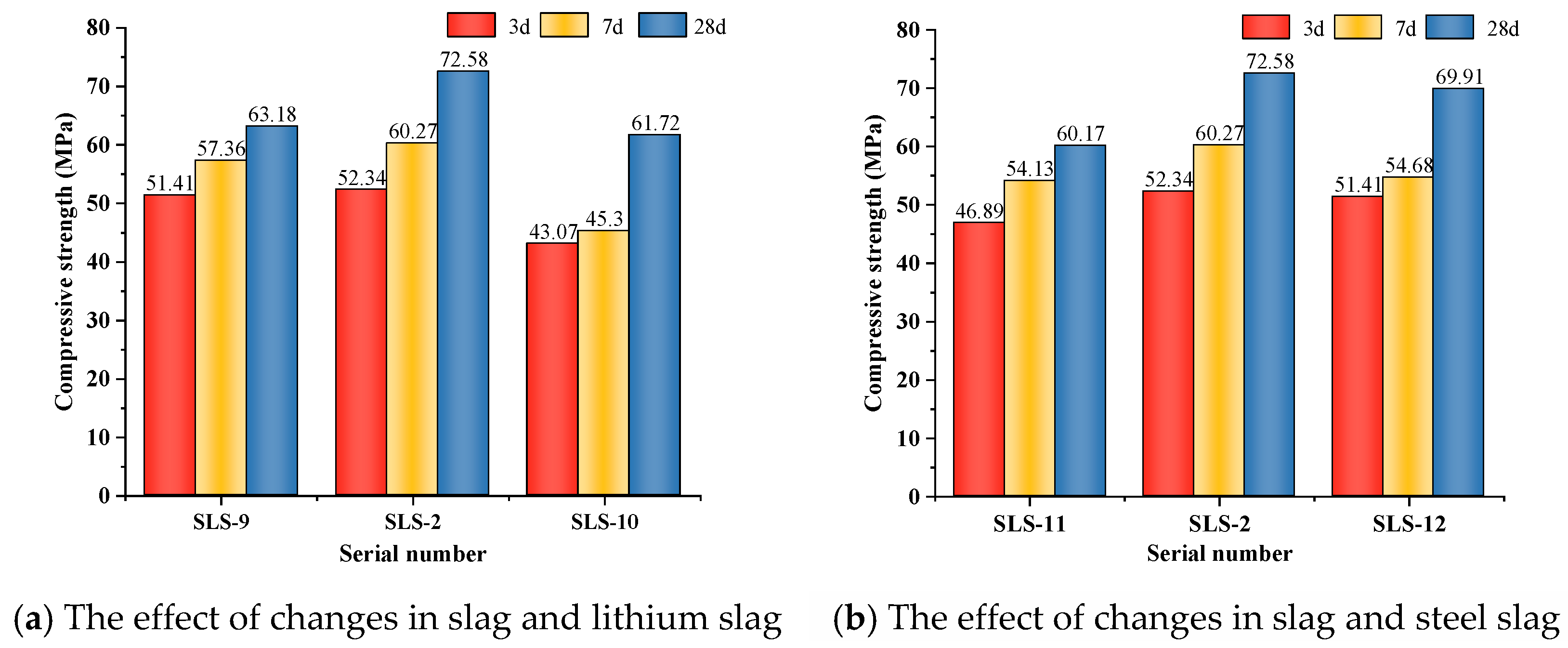
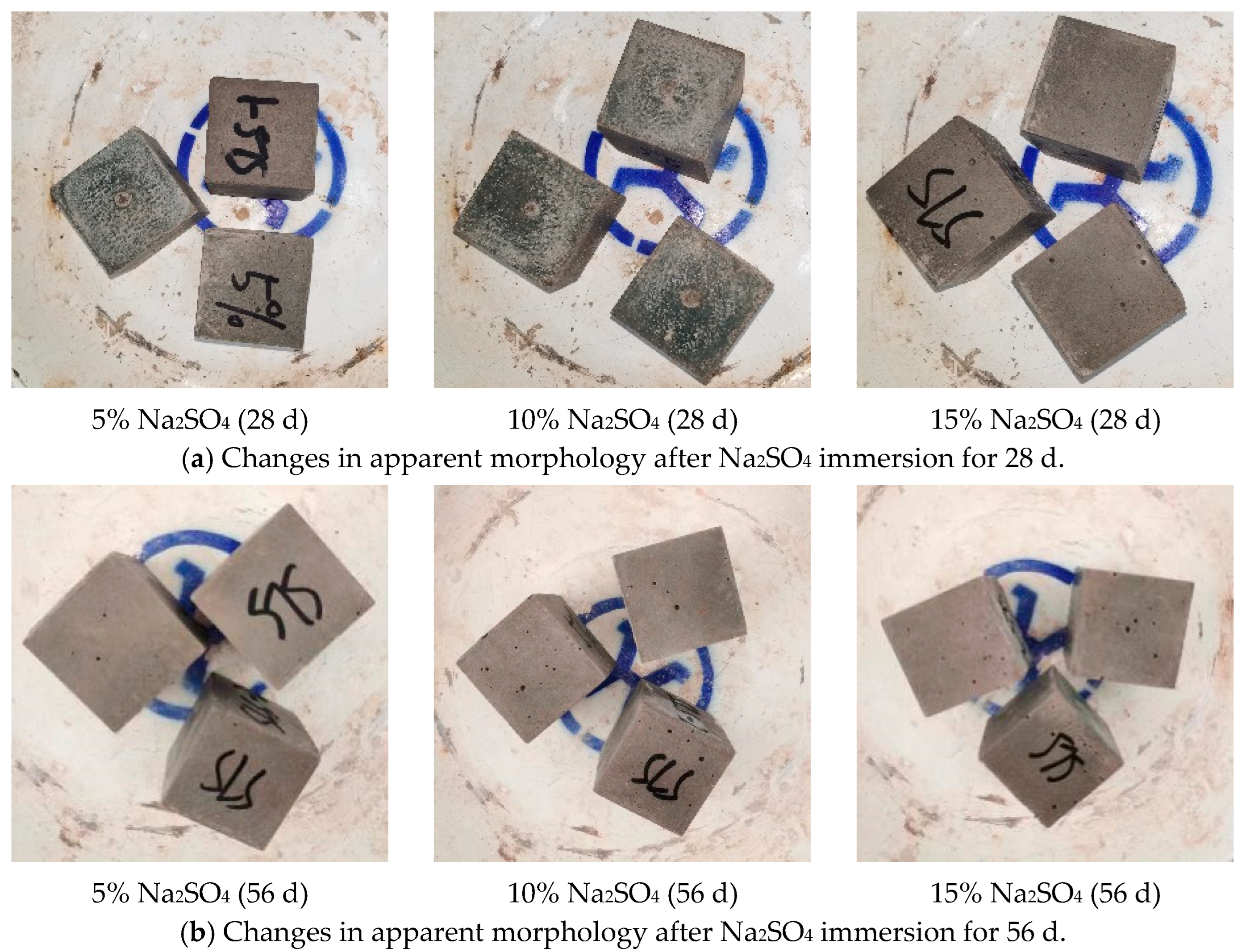

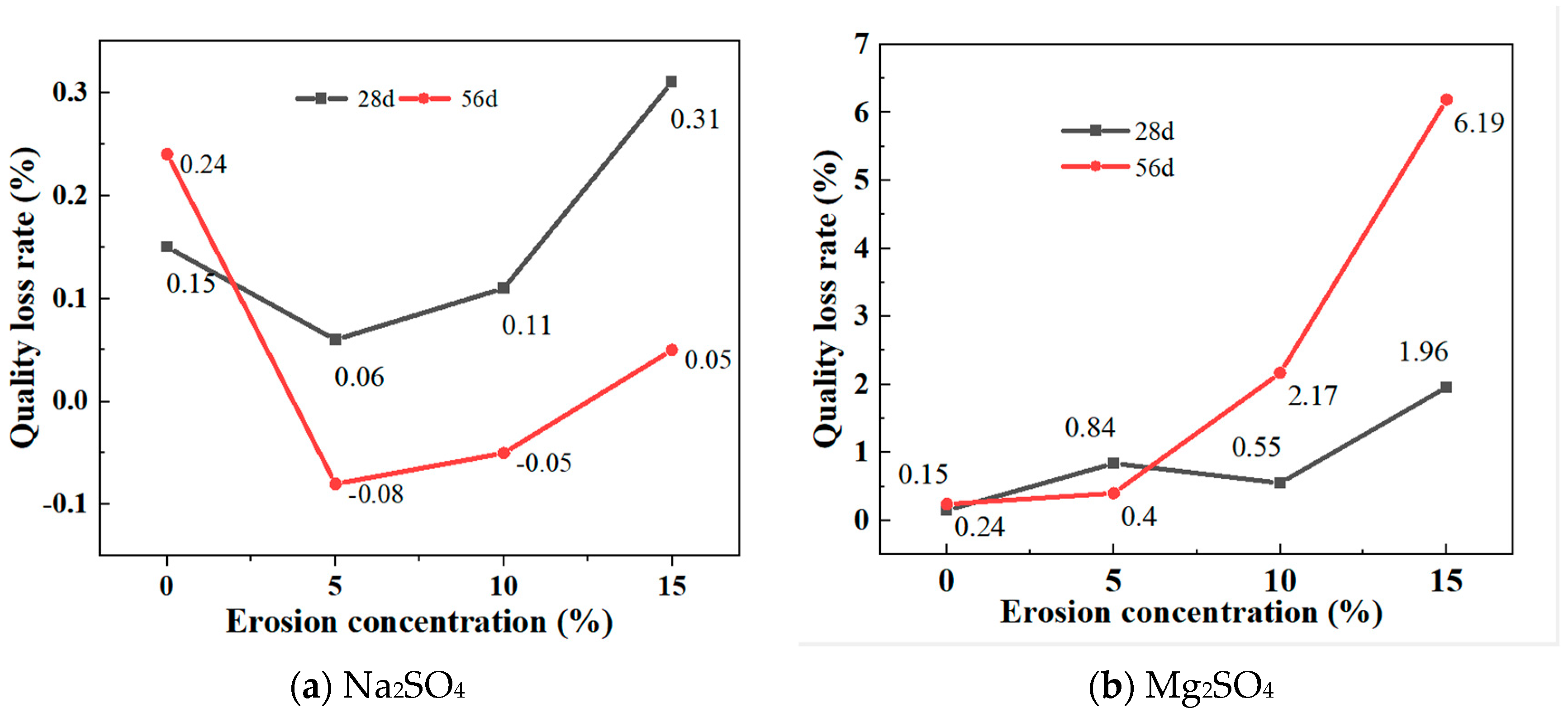
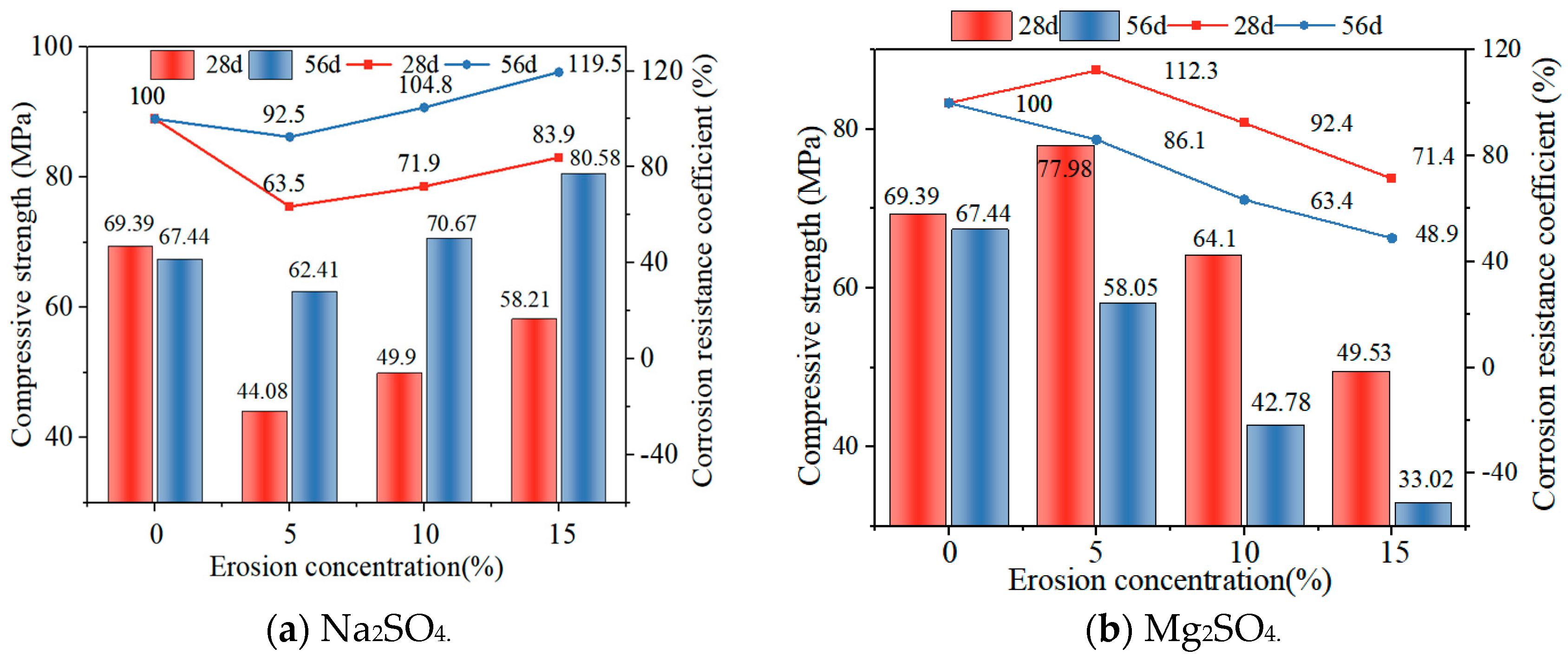
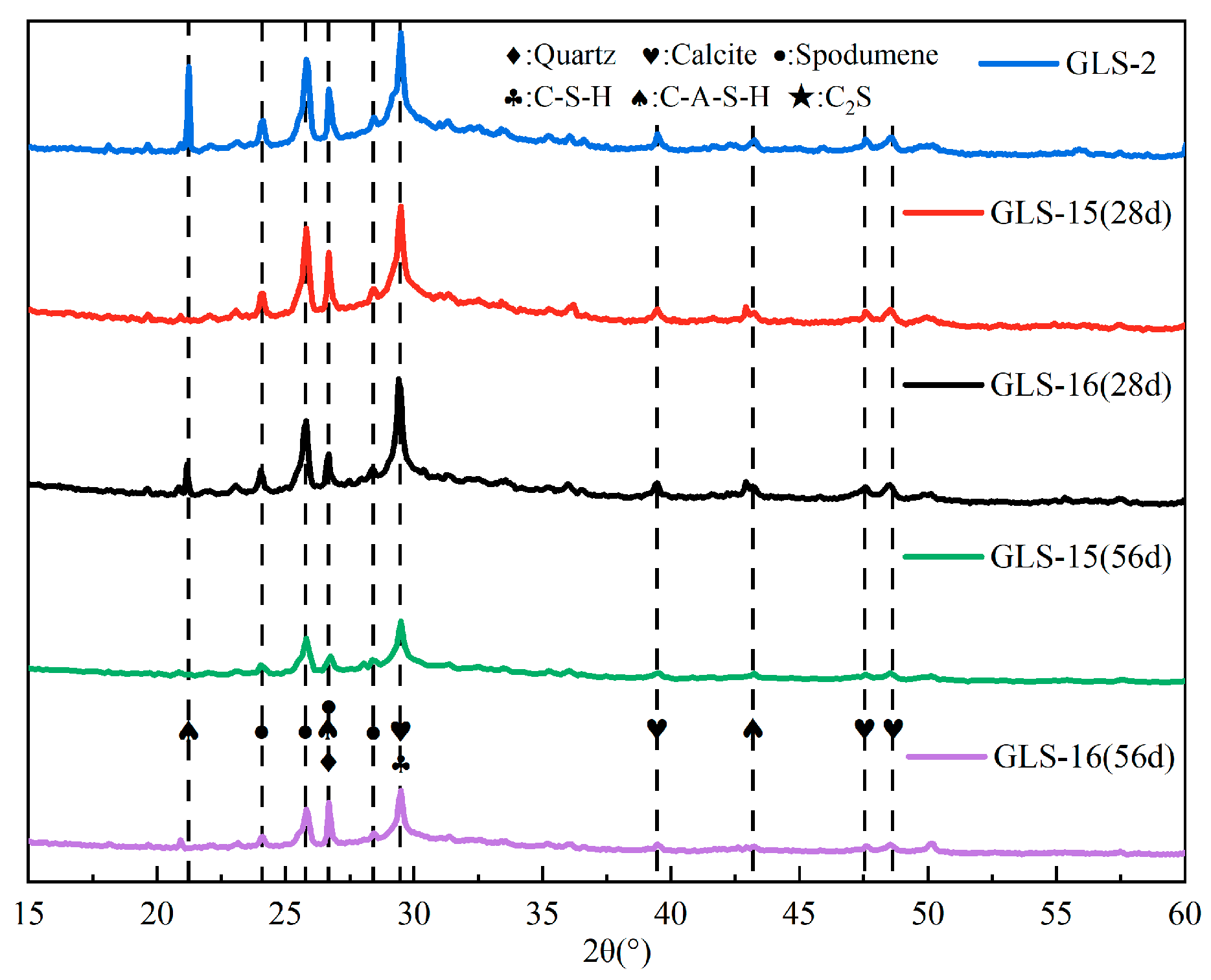
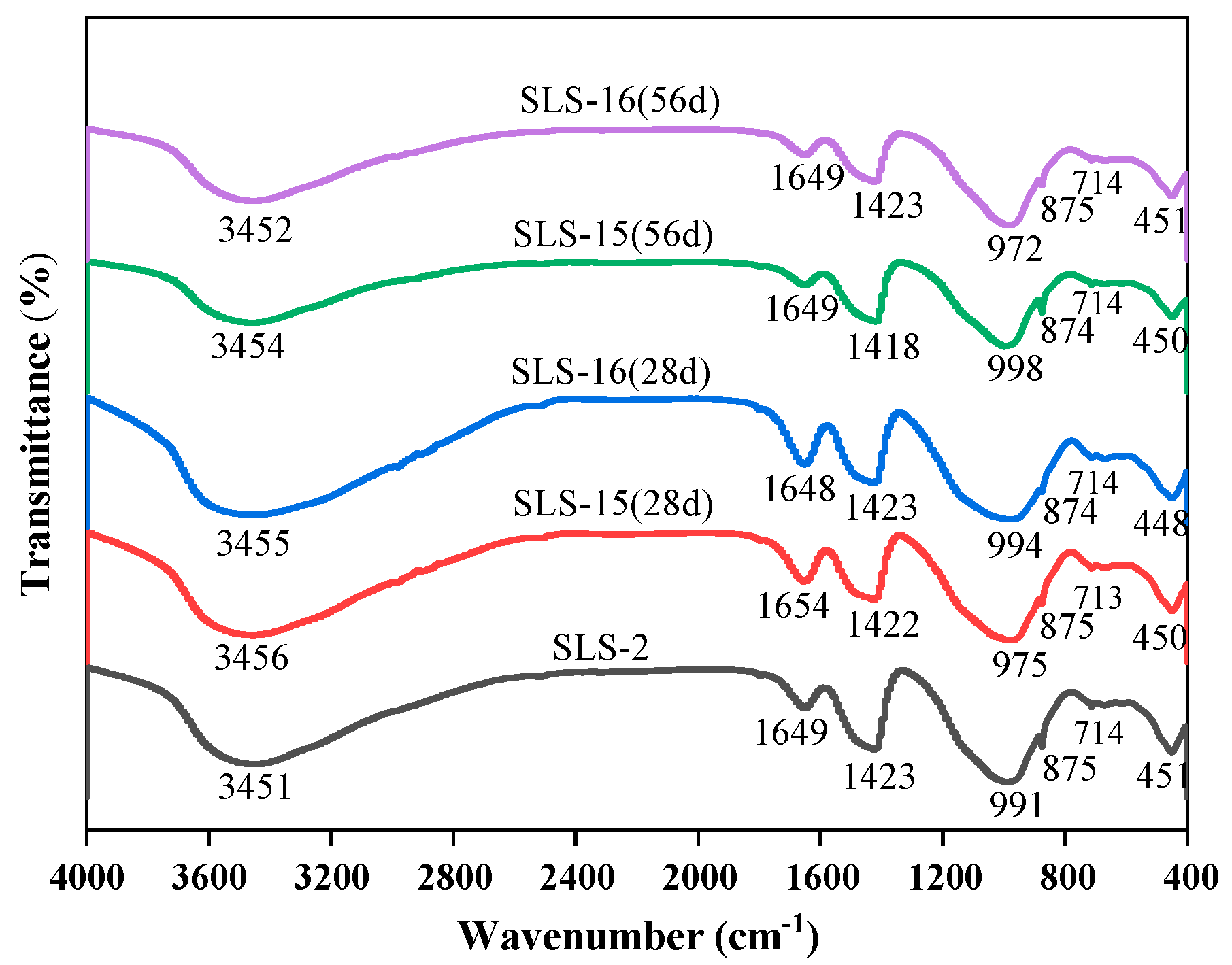




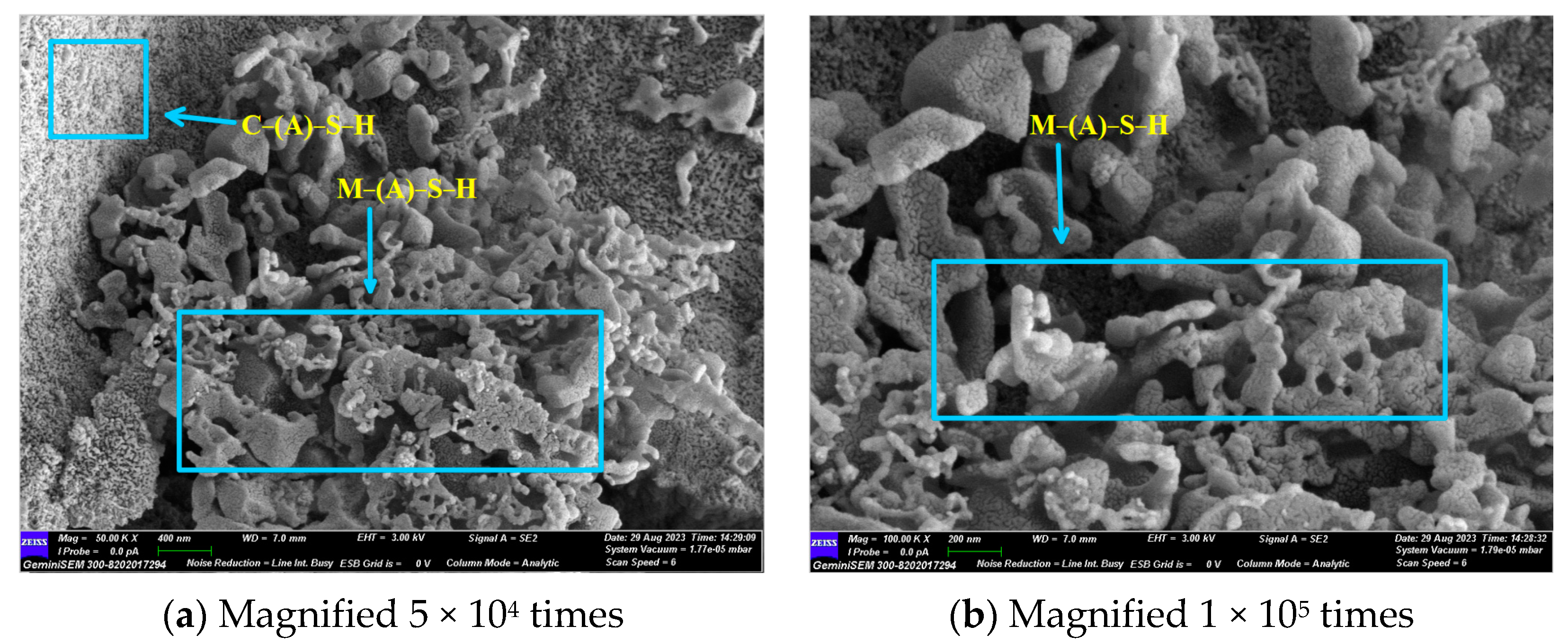

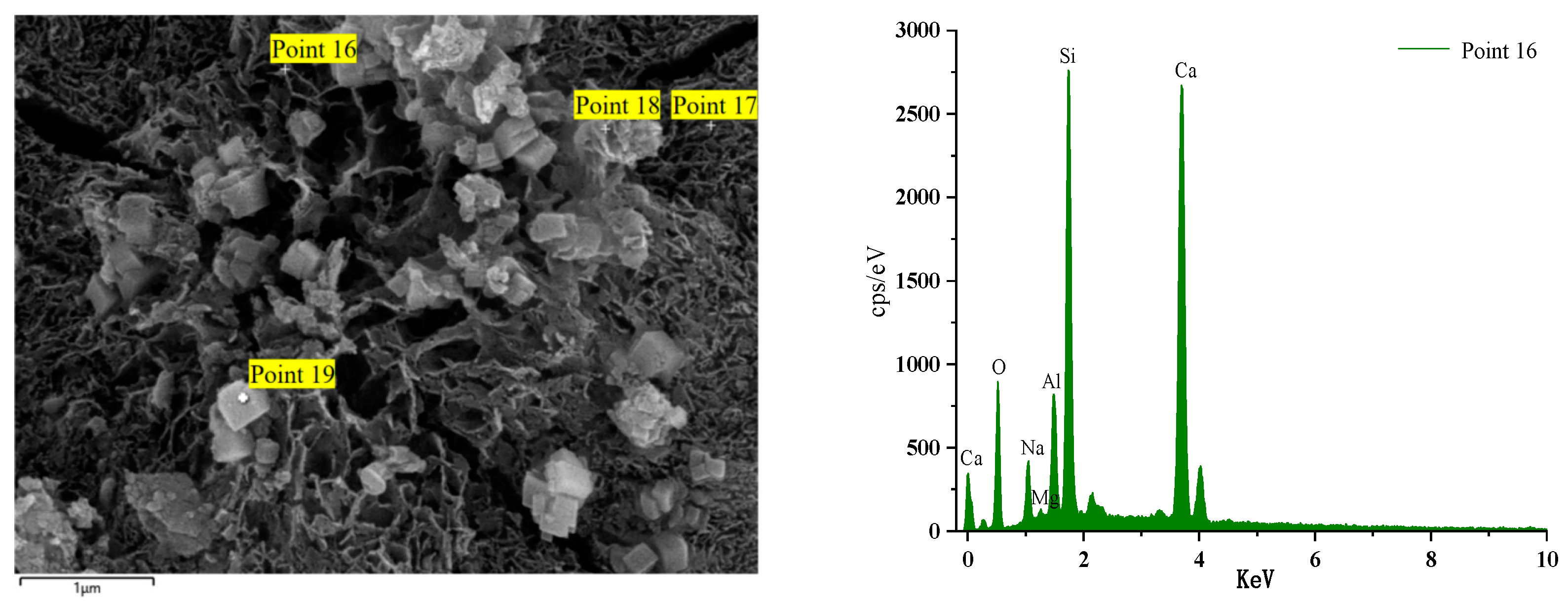

| Materials | GGBFS | LS | SS |
|---|---|---|---|
| CaO (wt.%) | 50.22 | 54.86 | 44.40 |
| SiO2 (wt.%) | 25.62 | 22.39 | 15.70 |
| Al2O3 (wt.%) | 12.07 | 13.72 | 5.45 |
| Fe2O3 (wt.%) | 0.31 | 1.27 | 20.56 |
| SO3 (wt.%) | 2.41 | 6.05 | 0.85 |
| MgO (wt.%) | 5.18 | 0.32 | 4.64 |
| K2O (wt.%) | 0.30 | 0.60 | 0.46 |
| SSA (cm2·g−1) | 2525 | 7623 | 10128 |
| D10 (μm) | 2.46 | 1.50 | 2.03 |
| D50 (μm) | 10.56 | 6.368 | 25.73 |
| D90 (μm) | 33.52 | 35.94 | 88.14 |
| Specimen Number | Mineral Mixing Ratio | Modulus of Alkali Activator | Alkali Activator Content/% | w/b Ratios | Immersion Solution | Series |
|---|---|---|---|---|---|---|
| GLS-1 | 60:20:20 | 1.3 M | 4 | 0.40 | - | A |
| GLS-2 | 60:20:20 | 1.3 M | 5 | 0.40 | Water | |
| GLS-3 | 60:20:20 | 1.3 M | 6 | 0.40 | - | |
| GLS-4 | 60:20:20 | 1.3 M | 7 | 0.40 | - | |
| GLS-5 | 60:20:20 | 1.4 M | 5 | 0.40 | - | B |
| GLS-6 | 60:20:20 | 1.5 M | 5 | 0.40 | - | |
| GLS-7 | 60:20:20 | 1.3 M | 5 | 0.38 | - | C |
| GLS-8 | 60:20:20 | 1.3 M | 5 | 0.42 | - | |
| GLS-9 | 50:30:20 | 1.3 M | 5 | 0.40 | - | D |
| GLS-10 | 70:10:20 | 1.3 M | 5 | 0.40 | - | |
| GLS-11 | 50:20:30 | 1.3 M | 5 | 0.40 | - | |
| GLS-12 | 70:20:10 | 1.3 M | 5 | 0.40 | - | |
| GLS-13 | 60:20:20 | 1.3 M | 5 | 0.40 | 5% Na2SO4 | E |
| GLS-14 | 60:20:20 | 1.3 M | 5 | 0.40 | 10% Na2SO4 | |
| GLS-15 | 60:20:20 | 1.3 M | 5 | 0.40 | 15% Na2SO4 | |
| GLS-16 | 60:20:20 | 1.3 M | 5 | 0.40 | 5% MgSO4 | |
| GLS-17 | 60:20:20 | 1.3 M | 5 | 0.40 | 10% MgSO4 | |
| GLS-18 | 60:20:20 | 1.3 M | 5 | 0.40 | 15% MgSO4 |
| Components | Wavenumber (cm−1) | Interatomic Bonds | Groups |
|---|---|---|---|
| C-S-H | 448–451 | O-Si-O | SiO44− |
| 874–875 | Si-O | SiO44− | |
| 972–991 | Si-O | SiO44− | |
| 3451–3456 | O-H | H₂O | |
| 1648–1654 | H-O-H | H₂O | |
| C-A-S-H | 713–714 | Si-O-Al | AlO4 |
| 874–875 | Si-O | SiO44− | |
| 972–991 | Si-O | SiO44− | |
| 3451–3456 | O-H | H₂O | |
| 1648–1654 | H-O-H | H₂O | |
| CaCO3 | 1418–1423 | C-O | CO32− |
| Number | C | O | Si | Al | Na | Ca | Mg | Ca/Si |
|---|---|---|---|---|---|---|---|---|
| GLS-2 | 18.91 | 57.10 | 6.94 | 2.91 | 7.63 | 5.14 | 1.15 | 0.74 |
| GLS-15 | 7.75 | 44.51 | 15.51 | 4.29 | 3.28 | 23.90 | 0.30 | 1.54 |
| GLS-16 | 12.72 | 60.47 | 7.65 | 4.04 | 4.82 | 6.33 | 3.56 | 0.83 |
Disclaimer/Publisher’s Note: The statements, opinions and data contained in all publications are solely those of the individual author(s) and contributor(s) and not of MDPI and/or the editor(s). MDPI and/or the editor(s) disclaim responsibility for any injury to people or property resulting from any ideas, methods, instructions or products referred to in the content. |
© 2024 by the authors. Licensee MDPI, Basel, Switzerland. This article is an open access article distributed under the terms and conditions of the Creative Commons Attribution (CC BY) license (https://creativecommons.org/licenses/by/4.0/).
Share and Cite
Zhang, S.; Zhang, Y.; Zhang, J.; Li, Y. Compressive Strength and Resistance to Sulphate Attack of Ground Granulated Blast Furnace Slag, Lithium Slag, and Steel Slag Alkali-Activated Materials. Buildings 2024, 14, 2320. https://doi.org/10.3390/buildings14082320
Zhang S, Zhang Y, Zhang J, Li Y. Compressive Strength and Resistance to Sulphate Attack of Ground Granulated Blast Furnace Slag, Lithium Slag, and Steel Slag Alkali-Activated Materials. Buildings. 2024; 14(8):2320. https://doi.org/10.3390/buildings14082320
Chicago/Turabian StyleZhang, Shunshan, Yannian Zhang, Jisong Zhang, and Yunkai Li. 2024. "Compressive Strength and Resistance to Sulphate Attack of Ground Granulated Blast Furnace Slag, Lithium Slag, and Steel Slag Alkali-Activated Materials" Buildings 14, no. 8: 2320. https://doi.org/10.3390/buildings14082320






